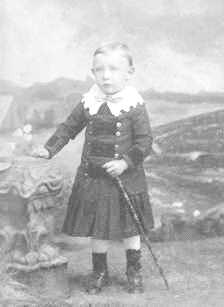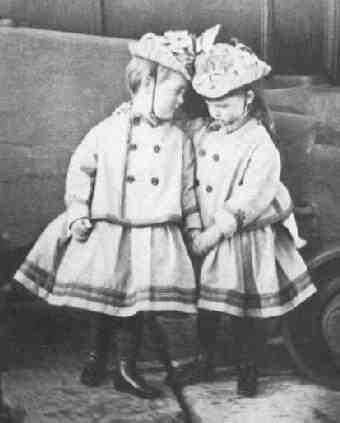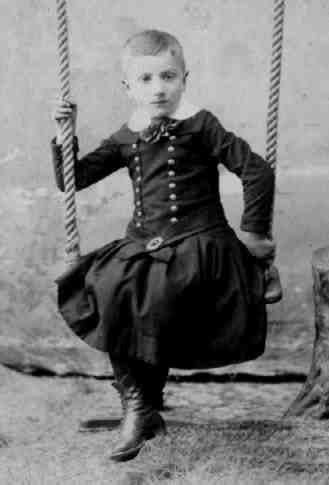Double Breasted Dresses for Boys

Figure 1.--This little American boy wears a dress with double-breasted styling in a photograph, probably taken in the 1880s. There is some velvet work between the rows of buttons and at the sleeve cuffs. The lace collar
which is not as large as the collars popular in the 1890s and is not repeated at the sleeve cuffs. Note the walking stick, even if the child did not have short hair, that would have signaled that he was a boy.
|
|
We are not sure when double-breasted styling for children first appeared or who initially conceived of the idea. Double-breasted garments for children must have been inspired by the dashing military uniforms of the early 19th Century. This may explain why double-breasted styling was mostly commonly use on dresses for boys. Double-breasted styles were
used in military uniforms well into the 2Oth Century. As is so often the case, the inspiration for many boys' fashions was the military. The first boys' garments to use the double-breasted style was the skeleton suit, but many other garments were
subsequently styled in the double-breasted fashion--including children's dresses.
Chronolgy
I am not sure when the dresses worn by little boys were first styled
in the double-breasted fashion. I have noted dresses from the 1860s,
but even earlier dresses may have been ddouble breasted. I do not yet
have any historical information. I am collecting
available images which hopefully will provide some insights on the
development of this important style.
My initial assessment based on admitedly insufficient evidence is that the double-breasted are styles which appeared in the second half of the 19th Century, primarily for boys. The approch I am employing in HBC is to make a preliminary assesment and then to modify it as additional evidence is received. Children's dresses in the forst half of the 19th Century were not
made destinctly for boys or girls. Specialized styles for boys developed in the second half of the century, especially after the 1870s. The double-breasted style was a favorite for these boys' dresses. The precise dating will depend on the other design elements or other accessories employed.

Figure 2.--This English image is undated, but I'd guess about the 1870s. The brother and sister (John and Beatrice Tynne) in matching dresses wear four buttons in a double-breasted style. Note the children's matching straw hats with flowers and elastic chin straps. While boys of the era commonly wore dresses, it was not as common to wear such girlish-looking
hats.
|
|
Styling
The earlist skeleton suits for boys had double breasted jackets with
a distinctive military look to the jackets. Dresses, even for boys, were
not done with this military look, despite the military origins of the
style. This was in part accomplished by limiting the number of buttons.
Button work
The double-breasted work was usually done primarily on the bodice or
jacket area of the dresses. Some outfits, however, did have the buttons
continuing into the skirt area.
The double breasted dresses had a wide variety and styles, much more
varied than the double breasted styles worn on skelketon and other suits.
In comparison to
the skeleton suits and mid-19th Century suits with large numbers of
buttons, some of the double breasted dresses had only four buttons. But
some dresses had very large numbers of buttons.
Belts
One common feature employed in the styling of double breasted dresses.
This became especially common beginning in the 1880s.
Collars
Double-breasted dresses were often worn with white collars of varrying size. The sizes tended to increase after the 1870s. They could be lace collars or even rounded or pointed Eton collars. The plain Eton collars
would be more common on the dresses worn by older boys.

Figure 3.--It was not just little boys that wore double-breasted dresses. I'm not sure how to date this image. The double-breasted styling looks like the 1870s to me. The collar is somewhat larger than common in the 1870s, so it might have been the late 1870s or early 1880s.
|
|
Country Preferences
I have not yetvdetected country prefrence as regards double-breasted
styling. I have noted extensive use of the dounle-breasted styling in
England, France, Italy, and the United States among other countries. Most
of the images I have are American and double-breasted styling was clearly
popular in the United States. I have yet to determine the relative
popularity in different countries.
Conventions
The double-breasted styling appears to have been more common on the
dresses for boys. Identifying gender in many of the avaialble photographs,
however, is difficult. There was no prohibition against girls wearing
double-breasted dresses. It does seem to have been less common for
girls to wear this style. When the double-breasted style is combined with
a belt as part of the styling it is further evidence that the child is
a boy. While some old photographs are easy to identify id the child has
short hair, children with long hair can be very difficult to identify.
Ages
Double-breasted dresses appeared to hav been worn by boys of all ages
before breaching. This included older bpys that were being kept in dresses by their
doting mothers. It does not seem to have been a style with any age
commotations.
HBC

Navigate the Boys' Historical Web Site Double Breasted Pages
[Return to the Main double-breasted page]
[Return to the Main dress style/page]
[Return to the Main dress page]
[]
[BD Kilts]
[BB Skeleton suits]
[DB Suits]
Navigate the Boys' Historical Clothing Web Site:
[Introduction]
[Activities]
[Biographies]
[Chronology]
[Clothing styles]
[Countries]
[Theatricals]
[Topics]
[Bibliographies]
[Contributions]
[FAQs]
[Glossaries]
[Images]
[Links]
[Registration]
[Tools]
[Boys' Clothing Home]
Created: March 8, 1999
Last updated: March 8, 1999



